Market Views: HDD Shipments Down 20% in Q1 2016, Hit Multi-Year Low
by Anton Shilov on May 12, 2016 8:00 AM ESTShipments of Client HDDs as a function of all Client Drives Drop
Long gone are the days when shipments of client HDDs by Seagate and Western Digital were around 75 million units per quarter. When PC sales drop to 60 – 66 million of units per quarter, it is simply impossible to sell that many drives. The two leading makers of HDDs supplied 45.7 million of hard disks in Q1 2016, down from 63.4 million from the same quarter last year. While Toshiba’s consumer drives should not be forgotten, it is evident that the increasing amount of new PCs use SSDs these days.
The SSD adoption rate in the notebook market in Q4 2015 was approximately 25~26%, according to TrendForce. In the first quarter that figure could easily go up because Seagate admitted that it did not want to play a part in certain areas of the low capacity notebook market. Moreover, as HDD platforms get more expensive in the coming years, hard drive makers may simply leave low-end bulk storage to SSD makers. In the end, it is relatively easy to build SSDs these days (it is not easy to manufacture NAND flash, of course), but HDD production involves a lot of R&D and state-of-the-art manufacturing facilities. As a result, companies like Seagate or Western Digital may simply lose interest in entry-level hard drives, especially given the fact that soon Western Digital will become a supplier of consumer SSDs as well.
As pointed out in the previous report, Seagate includes shipments of hard disk drives it sells for game consoles into its 2.5” client HDD category, whereas Western Digital includes its drives for consoles into its consumer electronics category. As a result, the picture is somewhat noisy here. Seagate sold 10.6 million 2.5” client HDDs in the first quarter, which is a drop of 37% from the same period a year ago. Since the company deliberately decided not to fight for low-end notebook deals, such a sharp decline is not something unexpected. Meanwhile, Western Digital supplied 13.6 million of its 2.5” client hard drives in Q1 2016, 28% less than in the same quarter last year.
Sales of client 3.5” HDDs by Seagate and Western Digital declined by 22.8% year-over-year, in line with the deterioration in the HDD market. Moreover, actual shipments of desktop hard disks were on the same level for the two leading makers: Seagate supplied 10.8 million units (a 24.5% drop YoY), whereas Western Digital shipped 10.7 million devices (a decrease of 21% YoY). We do not know how many 3.5” client hard drives Toshiba shipped in Q1, but it is safe to say that the market is on the decline in general and it does not make a lot of sense to fight for desktop market share these days.
In its recent conference call with investors and financial analysts, Seagate re-emphasized that it expected sales of its client drives to continue declining, but to keep gaining capacity. Historically, sales of Seagate’s client HDDs accounted for 60% of its revenue, whereas sales of enterprise products accounted for 40% of its revenue. Given the current market trends away from installing HDDs into tablets, 2-in-1 hybrid PCs or ultra-thin notebooks, client HDD revenue will eventually drop to 40% of Seagate’s revenue whereas enterprise hard drives will account for 60% of its revenue, the company revealed. With that said, it is expected that Seagate will focus on higher-capacity drives rather than on inexpensive devices that help to boost unit sales, as the latter is not something that is needed ion a weakening market.
Sales of External HDDs and NAS Fall
Because the number of PCs that cannot house more than one internal storage device is growing, external storage is getting some traction. Seagate and Western digital offer broad lineups of DAS and NAS devices under their own trademarks as well as under G-Technology and LaCie brands. While shipments of branded storage products do not drive huge volumes, this is a rather lucrative business for manufacturers offering higher ASPs.
Sales of branded DAS and NAS devices by Seagate and Western Digital totaled 10.357 million units in the first quarter of 2016, down 7.5% from 11.190 million units in Q1 2015. The two manufacturers sold an equal amount of external storage products: Seagate shipped 5.200 million branded devices (up 2% YoY), whereas Western Digital sold 5.157 million branded products (down 15.3% YoY). Historically, Western Digital outsold its main competitor with its My Cloud and My Passport external HDDs, but in the recent quarters Seagate has begun to catch up whereas sales of WD began to decline.
One thing that should be kept in mind when analyzing branded storage is that no matter how many HDDs are inside a DAS or a NAS, they are all considered as one unit (e.g., a WD My Book, a WD My Book Duo and a fully-populated My Cloud DL4100 are equal from accounting perspective). As a result, while we do see that unit sales of branded external storage by the two large makers have been slowly declining in the recent quarters, we do not know anything about the exact amount of drives inside as well as their storage capacities.
Consumer Electronics Still Consume A Lot of HDDs
The vast majority of consumer electronics (CE) devices nowadays use NAND flash memory. However, applications like set-top-boxes, DVRs, surveillance systems and game consoles remain sizeable consumers of hard drives, which is why makers of HDDs develop platforms specifically tailored for such devices.
Since shipments of Seagate’s CE HDDs do not include drives it supplies for game consoles (they are included in client 2.5” HDD sales), its CE business looks relatively stable and mostly driven by seasonality. In the first quarter of 2016, Seagate sold 5 million of CE HDDs, slightly up from 4.8 million supplied in the same period a year ago.
By contrast, Western Digital recognizes HGST Travelstar HDDs for Sony’s PlayStation 4 as consumer drives, which is why its CE numbers significantly depend on the production of PS4. Since in Q1 console sales and manufacturing are not on the rise, sales of Western Digital’s CE HDDs declined to 7.3 million units, down 15.2% from Q1 2015. The reasons for the drop are unclear - perhaps Sony decided to slow down PS4 production, or perhaps shipments of some other Western Digital products were not strong.
Anyway, due to account policies of the two leading makers of hard drives, it is impossible to compare their CE HDD businesses directly.


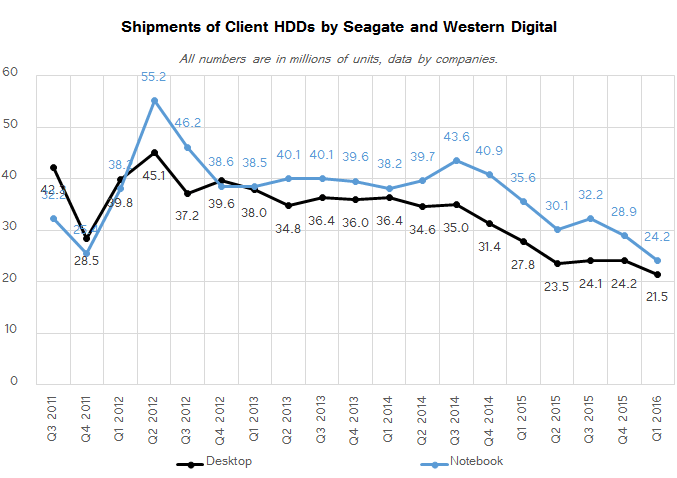
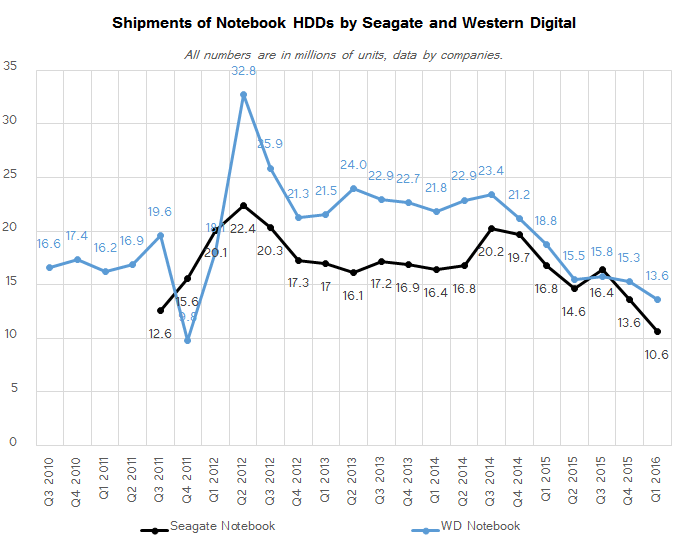
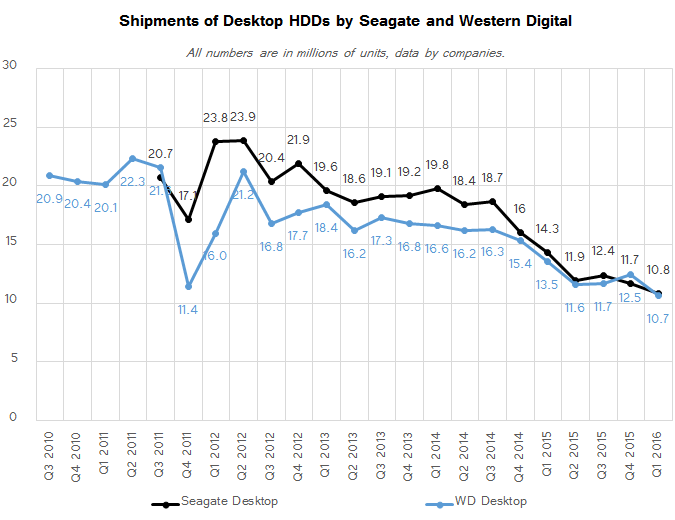
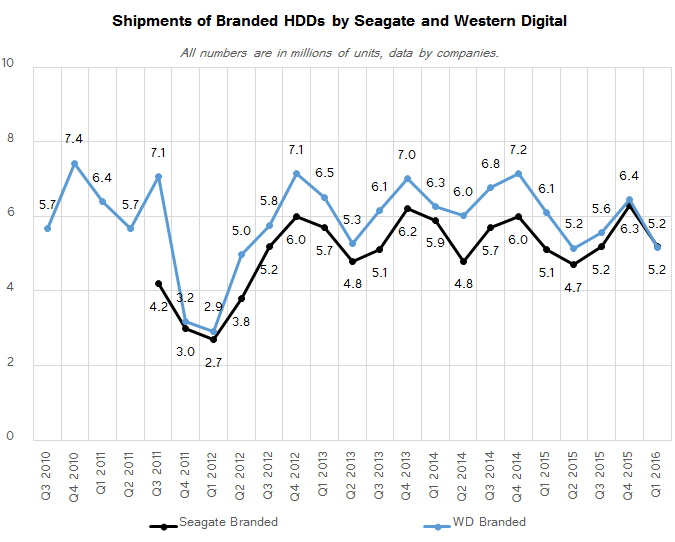
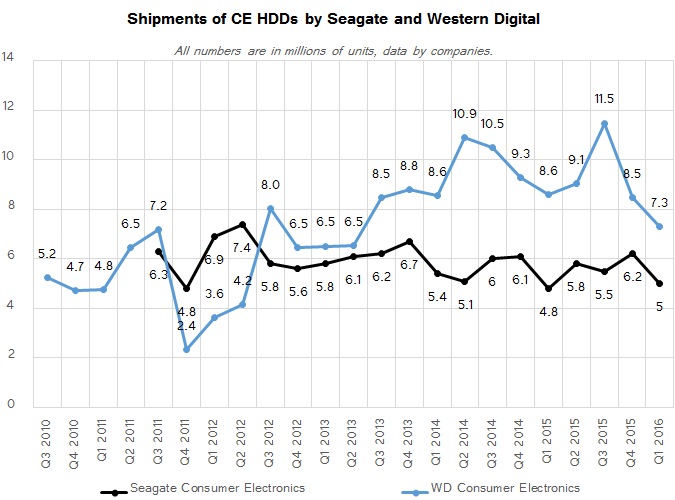








116 Comments
View All Comments
nils_ - Monday, May 30, 2016 - link
Is anyone still buying those 15k or even 10k drives?glad2meetu - Friday, May 13, 2016 - link
I think people are waiting to see what comes out of the merger between WD and Sandisk. I am surprised that Seagate did not make a bid late last year for Micron.I think much of the blame for the decline in the PC market in general is due to Intel failing to innovate. The drop in HDD shipments effectively just mirrors the lower number of new computers being shipped. But that may be a bit harsh on Intel and the rest of the PC industry. It has become much more difficult to make a game changing product given the level of excellence found in existing technology. The same can be said for smartphones.
Hard drives may turn around in another couple of years if designers can get hybrid drives to work as intended. Or perhaps 3D XPoint lives up to the hype and changes the market in another few years.
There also is a risk that the cost reduction on SSDs comes back to haunt them. General consumers will just lump all SSDs together or may view them based on brand names. So SSD makers could get hurt if the cheapest SSDs run into more issues for consumers.
avbohemen - Friday, May 13, 2016 - link
With these numbers, I am wondering: does this include disks delivered to the cloud providers (AWS, Azure, Google), Facebook and other big consumers? They are always expanding their datacenters and use a lot of storage, while no one seems to really know how big their "market share" is. Can anyone share some insight in this?Pix2Go - Friday, May 13, 2016 - link
The numbers in the article do include those customers. They typically are the ones using "Enterprise" drives, with some exceptions.As an idea of how many drives they need, consider this random nugget from "the internet":
"The volumes of storage Google needs are insane: as the post notes, YouTube alone requires a petabyte of new storage every single day."
Yep, at least 1000TB a day in new storage requirements. And I'd bet that's a low estimate.
This link doesn't give a solid answer, but gives some ideas about how much data is really out there. https://www.backblaze.com/blog/200-petabytes-of-cu...
revanchrist - Friday, May 13, 2016 - link
Couldn't agreed more with what some already said. The per GB price of HDD will not go further down, it will just stay stagnant. Right now the lowest per GB price is on 3TB and 4TB drives, once you go further up eyeing for 5TB and more, the prices simply rocket sky high. I think in the future, all those 1TB and 2TB drives will go extinct while 5TB and higher prices will drop down to the level of 3TB and 4TB. 1TB and lower storage space belongs to the SSD, and it will happen very soon.StrangerGuy - Friday, May 13, 2016 - link
My educated guess is that costs of HDDs doesn't scale well at the low end since HDD manufacturers still have to build the entire drive assembly minus platters for a 1TB or less HDD while NAND is far more flexible in physical packaging.zodiacfml - Friday, May 13, 2016 - link
LOL. I feel bad for these ageing kings of storage.They have to throw out their cash and apply for some loans to be build a NAND fab. It is the only way to stay relevant for the next 10 to 20 years. SSDs are already eating from the top and bottom of the food chain. The last remaining stronghold of HDDs is cost per GB; but SSDs doesn't have to go there as HDDs didn't replaced Tape drives for cost per GB.
zodiacfml - Friday, May 13, 2016 - link
Edit: Got carried away and forgot WDs acquisition of Sandisk which puts them on track. Seagate, just do it.vivekvs1992 - Saturday, May 14, 2016 - link
Most of the reasons for declining sales are because of steafy decline in the pricing of small to medium capacity ssd, hdd are used for long term storage nowadays and those drives are never below 1tb, personally i have 2 2tb usb hdd, 1 1tb usb hdd and a 2 tb in my build, and 2 more 2 tb beauties are on their way... The thing is many of my friends don't consider that they can add another hard disk without removing the old one in a desktop, another lot of them don't need so m7ch storage and the last lot are unaware of this data expansion methodFriendlyUser - Saturday, May 14, 2016 - link
For a lot of stuff we have gone from "owning" digital libraries to "subscribing". If people had to locally store their netflix content or their Amazon books and their MP3s, the need for space would have grown considerably. With a fast network you can always rely on re-downloading content you want, instead of storing.Also, in my opinion, the industry has stagnated. Price per GB is today similar to what I paid the last time I upgraded my HDs, in 2009. This is unacceptable. I know I would have bought a ton of 2.5" 2TB HDs for backups and the like, but they are still priced at ~$100. Too expensive... Plus, there has been little progress with hybrid HD/SSDs, which would be a great solution for people who don't want to mess with multiple drives. In fact, all I see is rebranding the same drive with slightly modified firmware and selling it as "NAS" or "workstation" or "IP camera" or "NAS pro" or "Storage" etc.
They have been milking us for too long. Time to start innovating.